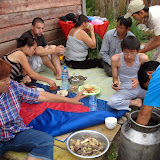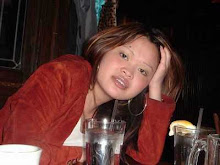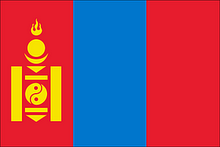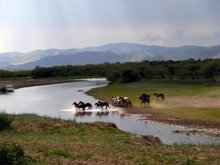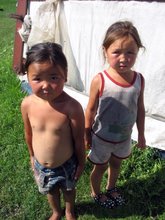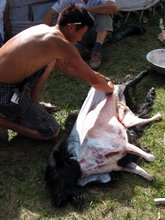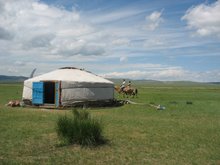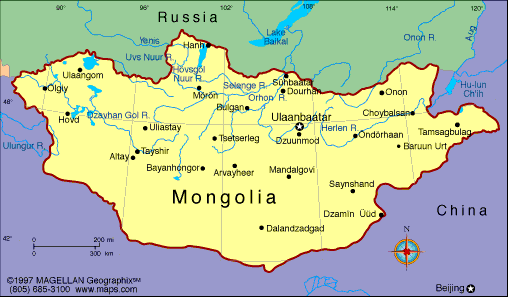Burengiin Nuruu Mountain Range

History of the Peace Corps Program in Mongolia
Country Assignment
- Country: Mongolia (Outter)
- Program: Youth Development
- Job Title: Life Skills Trainer (also: English teacher, Child Caretaker, Fund Raiser, Events Organizer, and IT Trainer)
- Orientation (Staging in Atlanta, GA): May 31-June 2, 2007
- Pre-Service Training (in Darkhan and Sukhbaatar, Mongolia): June 3-August 18, 2007
- Dates of Service (in Darkhan at Sun Children formerly "Asian Child Foundation" - a non-profit, non-government Japanese funded orphanage of 37 Mongolian children opened since 8/25/2005): August 19, 2007- August 18, 2009
Location and Nature of the Job
CYD Volunteers are placed in provincial centers with population between 15,000 and 70,000. A few CYD Volunteers are placed in Ulaanbaatar, where the population is reaching 1 million. I will work with youth-focused NGOs, children’s centers, schools, and civil society organizations to address major challenges confronting Mongolian youth today, such as education, life skills, employability, and leadership. In addition, the work will involve workshops and presentations at schools and community agencies and will entail traveling to other outlying communities that have less access to information and training. Given the vast distances in Mongolia, these visits will often require overnight stays.
Tuesday, July 31, 2007
A Cultural Miscommunication
Representing the Peace Corps as an American only highlights my identity insecurities. Ironically, it is not the native Mongolians in this country that raise such issues to the surface but my fellow American PCTs. Maybe it is my young looking face and short twenty-seven years that makes them lump me into the same group experience category as themselves. I wouldn’t mind this inaccuracy too much if it didn’t cause problems, but, as it was in the States and amplified here in Mongolia, this inaccurate label is the root of some of my communication problems.
Nowadays, I speak English without an accent, comprehending the language my in a way my parents still do not. Nonetheless, as a habit of learning English as a second language, I interpret what people say literally and ask many questions to clarify meaning. But English is a tricky language. There are hidden meanings behind the literal words that a native speaker expects another native speaker to understand. And when I don’t, I am quickly tagged as dim-witted and promptly laughed at or worse, made an enemy. A former boyfriend once accused me of “not listening” – a phrase I have heard uttered more frequently in the past two months. My attempt at clarification only causes frustration on the side of the ‘real’ native speaker and such situations usually end in dust clouds of hasty departures.
How ironic is it that in a foreign country, half way around the world from the place that I call home, do I feel more comfortable and accepted then when I’m with fellow Americans.
Saturday, July 28, 2007
Religion: Buddhism and Visit to the Buddhist Monastery, Амарбаясгалант Хийд
As a part of Cross-Culture Training for PST, all three host community groups had a schedule visit to Amarbayasgalant Khiid (Амарбаясгалант Хийд), one of the top three Buddhist monasteries in Mongolia. Amarbayasgalant Khiid was originally built between 1727 and 1737 by the Manchu emperor Yongzheng and dedicated to the Mongolian Buddhist Zanabazar, whose mummified body was later moved there in 1779. While touring the monastery grounds (27 temples and statues, though only five temples are open to tourists), I couldn’t help but noticed how similar the architecture was to Gyeongbokgung, the main palace of the Joseon Dynasty in Seoul, Korea. From the symmetrical layout to the imperial color scheme, the architecture was distinctively Chinese. I later found out that the monastery was built according to the Manchu style. My earlier thought makes sense given that both Mongolia and South Korea were influenced by the Chinese.
The history of Buddhism has a difficult past in Mongolian history. In 1924, when Bogd Khaan – the 8th Jebtzun Damba (reincarnated spiritual leader of Mongolia) – died, the then communist government prevented a successor from being found. The years of repression that followed peaked in the spring of 1937 when the government ordered the army to destroy religion. The obliteration that followed resulted in 700 monasteries being destroyed and 17,000 monks arrested, never to be seen again. Freedom of religion would not be restored until the democracy movement in 1990, 53 long years later.
Today, around 80% of Mongolians claim to be Buddhist of the Mahayana variety as practiced in Tibet (popularly known as Tibetan Buddhism). However, as culturally observed by curious PCTs, Mongolians tend not to be the practicing kind. In the northern aimags of Khentii, Selenge, Bulgan and Khovsgol, the Buddhism that is practiced is mixed with elements of Shamanism. This is largely because during the time of religious oppression, Shamanism survived because there were no books or buildings to destroy. And later on, with the installation of religious freedom, it co-existed in within the mix of Buddhism.
Two to three generations of Mongolians grew up without Buddhism. Maybe the reason why Mongolians identify themselves as Buddhist even though they don’t practice is because most people no longer understand the Buddhist rituals or their meanings, and the current standing monasteries in Mongolia suffer from a chronic lack of trained Buddhist lamas.
Friday, July 27, 2007
Heat Exhaustion: Mongolian Summers
Lately, it has been really hot. In the past week, the temperature has not dip below the 90F degree mark. Combined with the intense sun, it is no wonder that quite a few of us have been sick; the culprit, most likely being, heat exhaustion. In the States, one can escape the heat by ducking into the nearest building or public bus or moving vehicle, which most likely will be air conditioned. Here, there is no such luck. You would be lucky to find a fan let alone AC. Then there is the strange Mongolian phenomenon of eating hot food during hot sweltering days. There have been countless times I’ve come home from school for lunch in the peak of the hot afternoon to be greeted with steaming soup and boiling tea – right after my host sister comments on how hot it is outside (and in).
Thursday, July 26, 2007
Wednesday, July 25, 2007
Site Placement Announcements, Part I
Although I do share the same curiosity as my fellow trainees, I can’t help think how silly it is to waste such worries on something so minute. For me, my primary concern is not on where I will be living so much as what I will be doing. As a CYD volunteer, I wish to be setup with a Host Country Agency (HCA) that handles direct contact with children, particularly venerable children (i.e. orphans, shelter children, homeless children, children that already have been through the system or have been incarcerated). The PC application process and decisions up to this point were determined with little opinion from me; both the choice of host country and the job sector. If history dictates future, then I know my site placement will be determined based on need rather than personal opinion. Let’s hope I still have the same outlook come August 9th.
Tuesday, July 24, 2007
M18s: Group Description
Amongst us we have: a West Point Academy graduate, an experience horseback rider instructor, a published author of four books on Asian geopolitics, a mandolin musician, a certified massage therapist, a former snowmaker at a Maine ski resort, and a former employee on the Gerald R. Ford state funeral planning committee.
And we haven’t lost one yet, although there was a close-call on a medical evacuation; it turned out to be just a nice two week vacation in Thailand, the bastard. The PC worldwide statistics on Early Terminations (ET) (due to medical evacuation, administrative separation, or personal reasons), on average, is four by the end of PST and 20% of the total group before the end of the 27 month time commitment. With eight and a half weeks in country and a week left of PST, our group still retains all original 48 members. Maybe being ‘serious’ has its advantages.
Monday, July 23, 2007
Correspondence Match Program - Know of any teachers?
level) and was wondering if you or anyone you knew that was an educator would be interested in participating in this program? All I would need is their name and contact information before I swear-in – August 18, 2007. For more information, please go to the Peace Corps website at: www.peacecorps.gov/wws/
Saturday, July 21, 2007
Host Family Trip: Eej Mod (Mother Tree) and Elements of Shamanism
Eej Mod is place where Mongolians often come to seek solace and advice, and make offerings of vodka, milk, and khatag (a blue ceremonial silk scarf symbolizing the bestowal of blessings and good-luck wishes upon those who receive it). Mongolians revere the milk of the five domestic animals (sheep, goat, cow, camel, horse). They wish all things, especially human feelings, would be as white as milk. The color white is the symbol of all things beneficial – happiness, purity, and frankness. Like the ritual preformed when one encounters an ovoos (the large piles of rocks found on mountain passes, repositories of offerings for local sprits), pilgrims ask for a wish to be granted and circle the tree clockwise three times. Legend has it that a pregnant woman, seeking shelter from a heavy rain storm, sought refuge under this particular tree and gave birth to her child, hence the name, Eej Mod (Mother Tree).
Eej Mod (Mother Tree)
Where the mighty rivers of Orkhon Gol and the Selenge Gol meet.
Friday, July 20, 2007
The Pressures of Alcohol in Mongolian Culture and How to Properly Accept a Vodka Offering
When one is offered vodka (before the first round for it is also tradition to take three rounds of vodka; one cannot just get away with the courtesy one shot), there is a short ritual to honor Father Heaven, Mother Earth, and the ancestors. The ritual goes: dip your ring finger of your right hand (‘yadam khuruu’) into the glass, and lightly flick a drip once towards the sky, once towards the air ‘to the wind’ and once to the ground, and end with a wipe across your forehead. This expresses the following meaning:
Be serene, the blue sky!
Be calm, the hole earth!
Be contented, humankind!
Food and drink are accepted with the right hand; the left hand is only used to support the right elbow. Similarly, offerings are presented this way as well. Demonstration picture below (although this picture is slightly wrong – you can tell we are still in the learning stages; the host usually has the offering poured before presenting it, never does he let the guest hold the glass while he pours).
Thursday, July 19, 2007
"The Economist" Withdrawals
Mongol Ook (Mongolian Fat)
Wednesday, July 18, 2007
Safety and Security as a PCV in Mongolia: the Advantages of Looking Mongolian
Since my arrival in Mongolia, I have come to find that being mistaken for Mongolian has become of somewhat of an asset (I even have the same stylish fashion sense as Mongolian women; more on this later). While my fellow PCTs have had situations of harassment and difficulties as that “special American” that stands out like a sore thumb, I have gone unnoticed in my errands (e.g. visits to the bank, market, post office and internet café). I even get the “native discount” which is usually half of what they charge foreigners. However, since my Mongolian is still at a novice level, I immediately give myself away when I open my mouth to ask a question or to clarify a price, instantly revoking my ‘native discount’. This has happened enough times for me to keep quite, smile, and make a hasty departure. However, being the one that always gets spoken to when I’m with a group of my fellow PCV Americans (because they assume I am the sole Mongolian speaker), is getting a bit bothersome; apparently this asset comes with a silver lining.
Tuesday, July 17, 2007
Host Family Tragedy: A Death in the Family
The funeral was held in the khodoo (countryside), where my grandfather had lived and died. Since the funeral took place the day before my mid-LPI and two days before I left for Darkhan, I could not attend. The night before the funeral, the remainder of my family – two younger brothers and a younger sister – left for the khodoo. Up to this point, it had only been my host parents who had been away to be with the rest of the other family members. I, in turn, was left in good hands; my brother’s friend stayed two nights to guard the house and my sister’s friend came by the morning to cook me breakfast, lunch, and dinner, and help me prepare for my mid-LPI then left to go back to her house.
This all had happened before I received cross-culture training in the rituals of Mongolian funerals and passings, thus, I had no idea of what to do or what to say, if anything. So I did the one thing that came to mind, I gave a sentimental ‘happy gift’, one that I was going to save until end of PST but decided that now was a better time; I gave the gift of photographs (Mongolians absolutely love photographs; digital cameras and personal computers are rare here so hand-held glossy photographs are still treasured). Seventeen beautifully developed colorful photographs of a family trip to the Mongolia-Russian boarder, the khodoo (which included horseback riding, goat chasing, Mongolian song singing, a ger visit), and a picnic in Sainnii Hutul Peak National Park. My pictures now sit in a photo album all by themselves and proudly brought out with every new visitor to the house.
Some are displayed below:
.jpg)
.jpg)
.jpg)

Wednesday, July 11, 2007
Naadam – “The Three Manly Sports” (Erinn Gurvan Naadam)
Wrestling is national sport of Mongolia; it is the highlight of the Three Games of Men during Naadam (July 11-13). There are no weight categories or age limits in Mongolian national wrestling and during Naadam, every willing and curious man is given an equal chance to compete (including the American PC boys of Dulaankhaan host community; video footage link yet to be posted). The wrestlers wear heavy boots, a very small tight-fitting loincloth, a pair of sleeves which meet across the back of the shoulders resembling a tiny vestige of a jacket, and a pointed cap of velvet. It is rumored that this “uniform” came to be because during one Naadam, a woman had beaten all the contestants (wrestling is the one sport during Naadam that is reserved only for men to participate). The contestants come out on the field leaping and dancing, flapping their arms in imitation of an eagle (the “Eagle Dance”), then slaps with both hands his thighs and buttocks – a sign to his opponent that he is ready to begin.
2. Horse Racing
Mongolia’s second-biggest sport is horse racing. Jockeys are children between the ages of five and 12 (Mongolian children have been riding since infancy; “The nomad is born in the saddle”), racing their horses over open countryside rather than around a track; courses range from 15km-30km, depending on the age of the horses. The winning horse receives the honorary tile of ‘tumnii ek’ or ‘leader of 10,000’.


3. Archery
Archers use a bent composite bow made of layered horn, bark and wood. Arrows are made of willow and feathers from vultures and other birds of prey. The distance is 75m for men and 60m for women. Men shoot 40 arrows and must score greater than 15 points; women shoot 20 arrows and must score great than 13 points using the same bow. The winner earns the title of ‘mergeb’ or ‘super marksman’.
Sunday, July 8, 2007
An Ode to Mongolia: Summer Labor Camp, Түмэн Од Хөдөпмөр Зуслан
Dirt road, take me home
To the place, I belong
Mongolia, khodoo mama
Take me home
Dirt road
Camp activities included daily water fletching from the river 100 yards from site, chopping wood into thin pieces, help cook three meals a day for a group thirty-four 12-14 year olds and twenty adults using just a wood stove, picking wild strawberries, a two-hour long scavenger hunt, horseback riding, building 12-foot bonfires, and playing soccer and basketball (the number of American pro jerseys I saw would have been enough to compile a professional basketball team of their own).
Saturday, July 7, 2007
Culture Observation: The Popularity of Hair Dyeing
Tuesday, July 3, 2007
Replacing One National Holiday for Another
.jpg)
.jpg)
.jpg)
This day also marks the halfway point through PST (Pre-Service Training). The mid-LPIs (Language Proficiency Interviews) were given today (as practice for the final-LPIs in August). My Mongolian – after being in-country for over four weeks and three weeks of intensive language training at four hours a day/five days a week and living with a non-English speaking Mongolian family of five – is worse than my spoken Spanish. Knowing three previous languages before attempting to learn Mongolian actually leaves me at a disadvantage; my brain scrambles the vocabulary in one “dictionary” and what comes out is a combination of confusing phrases and sounds: “Muy Sain!”(Spanish-Mongolian). My tongue was not designed to pronounce “l-th” and “ts” sounds; I am doomed to sound like a blabbing foreigner in my site community for the next two years. For this, I am thankful that my program – CYD (Community Youth Development) – involves me working directly with children; they are far fairer judges of mistakes and blunders.
Naadam is also quickly approaching (July 11), a Mongolian national sports festival that celebrates the “three manly sports” – The Three Main Games of Men – of wrestling, archery, and horseracing. Under the old communist regime Naadam used to be preceded by military parades and workers’ demonstrations in central Ulan Bator’s Sukhbaatar Square (Сүхбаатарын талбай) to mark the anniversary of the establishment in 1921 of Mongolia’s revolutionary government. Nowadays, the three-day festival is held in the city stadium with a colorful ceremony combining national and quasi-religious elements.
Replacing one national holiday for another… Those wrestling underwear are another sight in themselves. I’ll post pictures of the festival as soon as I can.
Recommended Books on Mongolia
- “Dateline: An American Journalist in Nomad’s Land” by Michael Kohn, 2006.
- "Ghengis Khan and the Making of the Modern World” by Jack Weatherford, 2004.
- “Riding Windhorses” by Sarangerel, 2000.
- “Twentieth Century Mongolia” by Baabar, 1999.
Recommended Mongolian Movies
- The Story of the Weeping Camel (2004), Die Geschichte vom Weinenden Kamel
- Mongolian Ping Pong (2005), Lü cao di
Notable Articles on Mongolia
Informational Links
- Peace Corps - Mongolia
- International Calling Card (Cheap!)
- Current Mongolian News
- Current Weather Conditions in Ulannbaatar, Mongolia
- A Tour of Mongolia Through Photography
- History of Mongolia
- Mongolian Culture
- Mongolian Lanuage
- Weather and Climate In Mongolia
- Travel Guide to Mongolia
- Official Tourism Website of Mongolia
- Asia.com - Cheapest Airfare to Asia
- MIAT - Mongolian Airlines
- Currency Converter
- Entry and Visa Requirements


